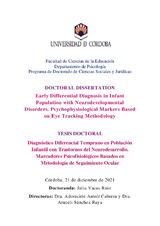Mostrar el registro sencillo del ítem
Early Differential Diagnosis in Infant Population with Neurodevelopmental Disorders. Psychophysiological Markers Based on Eye Tracking Methodology
| dc.contributor.advisor | Antolí Cabrera, Adoración | |
| dc.contributor.advisor | Sánchez Raya, Araceli | |
| dc.contributor.author | Vacas Ruiz, Julia | |
| dc.date.accessioned | 2022-03-10T07:43:34Z | |
| dc.date.available | 2022-03-10T07:43:34Z | |
| dc.date.issued | 2022 | |
| dc.identifier.uri | http://hdl.handle.net/10396/22668 | |
| dc.description.abstract | Early diagnosis and intervention have a positive impact on prognosis and the quality of life of children with neurodevelopmental disorders (NDDs) and their families. In this sense, the aim of this thesis project is to contribute to the early differential diagnosis of children with NDDs. To do so, we firstly investigated the cognitive profiles of five NDD with some kind of language disruption using the Wechsler Intelligence Scale for Children (see Appendix 1). From this study, we realized two issues: (1) That cognitive profiles were not highly conclusive or helpful for the purpose of differential diagnosis and (2) That we needed to bring forward the age of detection of the disorder to make real progress in early diagnosis. Thus, we carried out a comprehensive review on the issue and we focused the project on the analysis of the emotional competence (EC) in young children with Autism Spectrum Disorders (ASD) and Developmental Language Disorder (DLD). On the one hand, EC has proved to be more conclusive in yielding differences between disorders at early ages. On the other hand, ASD and DLD are two different NDDs which have demonstrated many similarities in behavioral, cognitive, and linguistic profiles at early ages. This inevitably hampers early diagnosis and, consequently, early intervention as revealed in our study on the prevalence and impact of the ‘Diagnostic Migration’ phenomenon between ASD and DLD on early intervention (see Appendix 2). Thus, the present doctoral dissertation was conceived to contribute to differential diagnosis of these conditions at early ages regarding their abilities in EC. With this purpose, we firstly conducted a thorough review of the state of the art and we understood that the construct of EC was too broad to be fully covered in this project; however, we found some key abilities which had been revealed as promising in differentiating disorders at early ages. These abilities were related to the visual processing of social-emotional images, whose analysis required eye tracking methodology. Then, we designed three intertwined experimental eye tracking studies to yield new evidence on the matter. Therefore, the first part of this work comprises three chapters which unfold the current knowledge on early diagnosis of NDDs, the evaluation of the EC in children with ASD and those with DLD, and the potential of eye tracking methodology to contribute to the definition of both conditions as well as to differential diagnosis. The second part of this work includes four chapters describing the experimental studies carried out. The former one explains the rationale of the three studies as well as their goals, the participants involved in them, the main hypotheses, and the designs. The other three chapters present a detailed reproduction of each study. As it was previously mentioned, we applied an eye tracking methodology along with a paired preference paradigm in all studies to describe the way in which young children with ASD and DLD observe and process social-emotional images. In this sense, the eye tracking methodology allowed us to describe children eye movements during images visualization; while the paired preference paradigm (consisting of the presentation of pairs of images to analyze their saliency and the competing effect of each one on each other) enabled us to identify which stimuli were more visually salient for children and which were able to capture or prevent their attention. Thus, by applying these methodological considerations in our three studies we have unveiled some psychophysiological markers that may contributed to the early identification of children with ASD and DLD (e.g., late orientation to angry and child faces, emotional sensitivity -visual preference for emotional faces with respect to the neutral ones-, and more superficial facial processing compared to their typical controls). Finally, the third part of this work consists of one chapter discussing the main results derived from the whole project, stating its limitations, providing some guidelines for future research, and remarking some final conclusions. Hence, this doctoral dissertation scientifically contributes to the current knowledge on the field in several ways: (1) Providing an exhaustive revision of the insight into the social-emotional competence in child populations with ASD and DLD; (2) Developing and consolidating a specific methodology based on the eye tracking technology and the paired preference paradigm, which allows a thorough study of these clinical populations boosting their comprehension and differentiation; (3) Revealing psychophysiological markers in young children with ASD and potential descriptors of visual scanning of faces in young children with DLD; and (4) Indicating new pathways for addressing the issue in future studies. | es_ES |
| dc.format.mimetype | application/pdf | es_ES |
| dc.language.iso | eng | es_ES |
| dc.publisher | Universidad de Córdoba, UCOPress | es_ES |
| dc.rights | https://creativecommons.org/licenses/by-nc-nd/4.0/ | es_ES |
| dc.subject | Neurodevelopmental disorders | es_ES |
| dc.subject | Autism spectrum disorders | es_ES |
| dc.subject | Developmental language disorder | es_ES |
| dc.subject | Childhood | es_ES |
| dc.subject | Early diagnosis | es_ES |
| dc.subject | Early intervention | es_ES |
| dc.subject | Eye tracking | es_ES |
| dc.subject | Specific language impairment | es_ES |
| dc.subject | Emotional competence | es_ES |
| dc.subject | Social attention | es_ES |
| dc.subject | Psychophysiological markers | |
| dc.title | Early Differential Diagnosis in Infant Population with Neurodevelopmental Disorders. Psychophysiological Markers Based on Eye Tracking Methodology | es_ES |
| dc.title.alternative | Diagnóstico Diferencial Temprano en Población Infantil con Trastornos del Neurodesarrollo. Marcadores Psicofisiológicos Basados en Metodología de Seguimiento Ocular | es_ES |
| dc.type | info:eu-repo/semantics/doctoralThesis | es_ES |
| dc.rights.accessRights | info:eu-repo/semantics/openAccess | es_ES |

